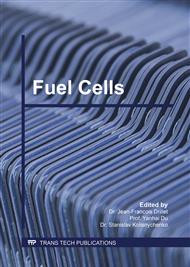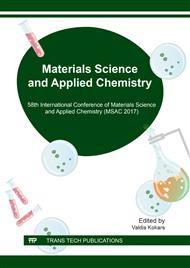[1]
M.L. Di Vona, D. Marani, D'Epifanio, S. Licoccia, I. Beurroies, R. Denoyel, P. Knauth, Hybrid materials for polymer electrolyte membrane fuel cells: Water uptake, mechanical and transport properties, J. Membr. Sc. 304 (2007) 76-81.
DOI: 10.1016/j.memsci.2007.07.013
Google Scholar
[2]
A. Basile, L. Patuurzo, A. Iulianelli, I. Gatto I, E. Passalacqua, Sulfonated PEEK-WC membranes for proton exchange membrane fuel cell: Effect of increasing level of sulfonation on electrochemical performances, J. Membr. Sc. 281 (2006) 377-385.
DOI: 10.1016/j.memsci.2006.04.006
Google Scholar
[3]
C. Fiori, A. Dell'Era, F. Zuccari, A. Santiangeli, A. D'Orazio, F. Orencchini, Critical review of fuel cell's membranes and identification of alternative types for automotive applications, Int. J. Hydrogen Energy 40 (2015) 11949-11959.
DOI: 10.1016/j.ijhydene.2015.03.105
Google Scholar
[4]
J. Chen , M . Asano, Y. Maekawa, M. Yoshida, Fuel cell performance of polyetheretherketone-based polymer electrolyte membranes prepared by a two-step grafting method, J. Membr. Sci. 319 (2008) 1-4.
DOI: 10.1016/j.memsci.2008.03.046
Google Scholar
[5]
J. Chen, D. Li D, H. Koshikawa, M. Zhai, M. Asano M, H. Oku, Y. Maekawa Y, Modification of ultrathin polyetheretherketone film for application in direct methanol fuel cells, J. Membr. Sci. 344 (2009) 266-274.
DOI: 10.1016/j.memsci.2009.08.016
Google Scholar
[6]
H. Luo, G. Vaivars, M. Mathe, Cross-linked PEEK-WC proton exchange membrane for fuel cell, Int. J. Hydrogen Energy 34 (2009) 8616-8621.
DOI: 10.1016/j.ijhydene.2009.08.024
Google Scholar
[7]
K. Umemura, T. Wang, M. Hara, R. Kuroda, O. Uchida, M. Nagai, Nanocharacterization and nanofabrication of a nafion thin film in liquids by atomic force microscopy, Langmuir 22, 7 (2006) 3306-3312.
DOI: 10.1021/la051926t
Google Scholar
[8]
N. Takimoto, L. Wu, A. Ohira, Y. Takeoka, M. Rikukawa, Hydration behaviour of perfluorinated and hydrocarbon-type proton exchange membranes: relationship between morphology and proton conduction, Polymer 50 (2009) 534-540.
DOI: 10.1016/j.polymer.2008.11.029
Google Scholar
[9]
M.A. Vandiver, B.R. Caire, J.R. Carver, K. Waldrop, M.R. Hibbs, J.R. Varcoe, A.M. Herring, M.W. Liberatore, Mechanical characterization of anion exchange membranes by extensional rheology under controlled hydration, J. Electrochem. Soc. 161, 10 (2014).
DOI: 10.1149/2.0971410jes
Google Scholar
[10]
A. Khawam, D.R. Flanagan, Basics and applications of solid-state kinetics: A pharmaceutical perspective, J. Pharmaceutical Soc. 95, 3 (2006) 472-498.
DOI: 10.1002/chin.200623291
Google Scholar



